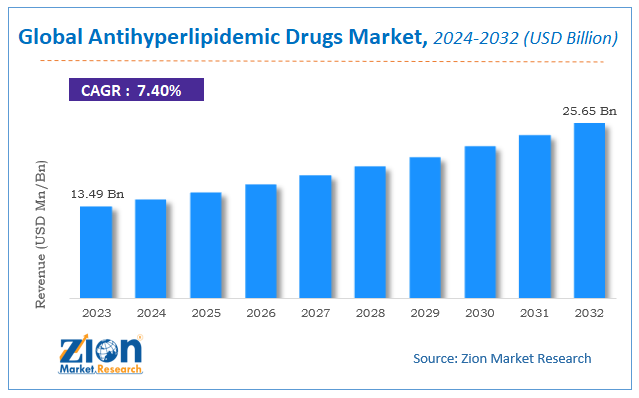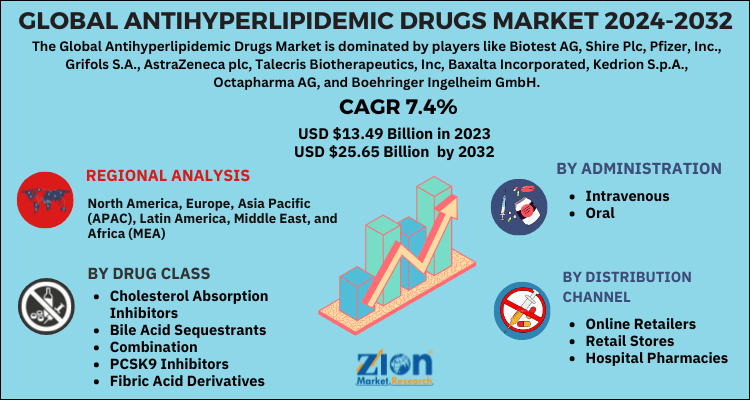Antihyperlipidemic Drugs Market Size, Share, Trends, Growth and Forecast 2032

Antihyperlipidemic Drugs Market By administration (intravenous and oral), By drug class (Cholesterol absorption inhibitors, bile acid sequestrants, statins, combination, PCSK9 inhibitors, and fibric acid derivatives), By distribution channel (online retailers, retail stores, and hospital pharmacies) And By Region: - Global And Regional Industry Overview, Market Intelligence, Comprehensive Analysis, Historical Data, And Forecasts, 2024-2032
| Market Size in 2023 | Market Forecast in 2032 | CAGR (in %) | Base Year |
|---|---|---|---|
| USD 13.49 Billion | USD 25.65 Billion | 7.4% | 2023 |
Description
Antihyperlipidemic Drugs Market Insights
According to the report published by Zion Market Research, the global Antihyperlipidemic Drugs Market size was valued at USD 13.49 Billion in 2023 and is predicted to reach USD 25.65 Billion by the end of 2032. The market is expected to grow with a CAGR of 7.4% during the forecast period. The report analyzes the global Antihyperlipidemic Drugs Market's growth drivers, restraints, and impact on demand during the forecast period. It will also help navigate and explore the arising opportunities in the Antihyperlipidemic Drugs industry.
Global Antihyperlipidemic Drugs Market: Overview
Hyperlipidemia also referred to as hyperlipoproteinemia, is a lipid condition characterized by elevated lipid (fat) levels in the blood. It's caused by a problem with lipid metabolism, a problem with plasma lipoprotein production & breakdown, or a plasma lipid transport. Hyperlipidemia is a serious medical problem that must be addressed. Lipid-lowering medications also called cholesterol-lowering, or antihyperlipidemic drugs, are a class of drugs that are used to lower high blood levels of lipids (fats) and lipoproteins (fats containing protein). These medicines are meant to treat cardiovascular disorders such as atherosclerosis and reduce the risk of heart attacks.
Global Antihyperlipidemic Drugs Market: Growth Factors
The global antihyperlipidemic drugs market is fueling at a speedy rate. The prime factor contributing to the growth of the market is the rise in cases of hyperlipidemia and cardiovascular diseases. CVD is the world's leading cause of mortality. In 2019, 17.9 million individuals died from cardiovascular disease (CVD), accounting for 32% of all deaths worldwide. Heart attacks and strokes were responsible for 85 percent of these fatalities. CVD is also the biggest cause of mortality in Europe, responsible for 47 percent of women's deaths and 39 percent of men's deaths.
Furthermore, according to a survey by faculty members at the University Putra Malaysia's Department of Nutrition and Health Sciences, cardiovascular diseases are anticipated to cause seven out of every ten fatalities in developing countries by 2020. This is leading to the huge demand for antihyperlipidemic drugs, thereby driving the market growth. In addition to this, an increase in sedentary lifestyle, rise in healthcare expenditure, and rise in geriatric population are also some of the key factors that are driving the global market.
Furthermore, in the near future, significant research and development of antihyperlipidemic combination drugs is expected to boost the global antihyperlipidemic drugs market. However, the increased cost of therapy, as well as strict government rules and laws around medication patents, may limit the global antihyperlipidemic drugs market growth.
COVID-19 was formerly assumed to be a virus that only affected the lungs, but it has now been shown that it may also affect and damage the heart, posing a higher risk of consequences for the many individuals worldwide who already have or are at risk of heart disease. Cardiovascular problems are common in COVID-19 patients, and these, together with pre-existing cardiovascular comorbidities and RF, may lead to severe clinical outcomes and death. Clinicians all across the globe should be aware of this link in order to identify patients who are at higher risk. In the projection period, the increased prevalence of illness among CVD patients would fuel the rise of antihyperlipidemic drugs.
Global Antihyperlipidemic Drugs Market: Segmentation
The global antihyperlipidemic drugs market is bifurcated based on the route of administration, drug class, distribution channel, and region.
Based on the route of administration, the global market is divided into intravenous and oral.
Cholesterol absorption inhibitors, bile acid sequestrants, statins, combination, PCSK9 inhibitors, and fibric acid derivatives are the drug class of antihyperlipidemic drugs.
The distribution channel segment is classified into online retailers, retail stores, and hospital pharmacies.
Antihyperlipidemic Drugs Market: Report Scope
| Report Attributes | Report Details |
|---|---|
| Report Name | Antihyperlipidemic Drugs Market |
| Market Size in 2023 | USD 13.49 Billion |
| Market Forecast in 2032 | USD 25.65 Billion |
| Growth Rate | CAGR of 7.4% |
| Number of Pages | 206 |
| Key Companies Covered | Biotest AG, Shire Plc, Pfizer, Inc., Grifols S.A., AstraZeneca plc, Talecris Biotherapeutics, Inc, Baxalta Incorporated, Kedrion S.p.A., Octapharma AG, and Boehringer Ingelheim GmbH |
| Segments Covered | By route of administration, By drug class, By distribution channel and By Region |
| Regions Covered | North America, Europe, Asia Pacific (APAC), Latin America, Middle East, and Africa (MEA) |
| Base Year | 2023 |
| Historical Year | 2018 to 2022 |
| Forecast Year | 2024 - 2032 |
| Customization Scope | Avail customized purchase options to meet your exact research needs. Request For Customization |
Global Antihyperlipidemic Drugs Market: Regional Analysis
In terms of revenue, North America is anticipated to lead the global antihyperlipidemic drugs market, and this trend is expected to continue over the projected period. The market for antihyperlipidemic drugs in North America is expected to grow as the frequency of vascular disorders and the number of amputations in the area rise. North American market expansion may also be ascribed to significant expenditures in R&D and healthcare spending by governments and commercial companies in the prosthetics industry in the area. In terms of market share for antihyperlipidemic drugs, Europe is expected to hold the second position in the market. This is owing to mandatory medical insurance in nations like France and Germany, as well as significant disposable income and considerable R&D activity in the region's healthcare industry.
Global Antihyperlipidemic Drugs Market: Competitive Players
- Biotest AG
- Shire Plc
- Pfizer, Inc.
- Grifols S.A.
- AstraZeneca plc
- Talecris Biotherapeutics, Inc
- Baxalta Incorporated
- Kedrion S.p.A.
- Octapharma AG
- Boehringer Ingelheim GmbH
are the dominating players that are functioning in the global antihyperlipidemic drugs market.
The Global Antihyperlipidemic Drugs Market is segmented as follows:
By administration
- intravenous
- oral
By drug class
- Cholesterol absorption inhibitors
- bile acid sequestrants
- statins
- combination
- PCSK9 inhibitors
- fibric acid derivatives
By distribution channel
- online retailers
- retail stores
- hospital pharmacies
Global Antihyperlipidemic Drugs Market: Regional Segment Analysis
- North America
- The U.S.
- Canada
- Europe
- France
- The UK
- Spain
- Germany
- Italy
- Rest of Europe
- Asia Pacific
- China
- Japan
- India
- South Korea
- Southeast Asia
- Rest of Asia Pacific
- Latin America
- Brazil
- Mexico
- Rest of Latin America
- Middle East & Africa
- GCC
- South Africa
- Rest of Middle East & Africa
What Reports Provides
- Full in-depth analysis of the parent market
- Important changes in market dynamics
- Segmentation details of the market
- Former, on-going, and projected market analysis in terms of volume and value
- Assessment of niche industry developments
- Market share analysis
- Key strategies of major players
- Emerging segments and regional markets
- Testimonials to companies in order to fortify their foothold in the market.
Table Of Content
FrequentlyAsked Questions
The global antihyperlipidemic drugs market is fueling at a speedy rate. The prime factor contributing to the growth of the market is a rise in cases of hyperlipidemia and cardiovascular diseases. In addition to this, an increase in sedentary lifestyle, rise in healthcare expenditure, and rise in geriatric population are also some of the key factors that are driving the global market. Furthermore, in the near future, significant research and development of antihyperlipidemic combination drugs is expected to boost the global antihyperlipidemic drugs market.
Biotest AG, Shire Plc, Pfizer, Inc., Grifols S.A., AstraZeneca plc, Talecris Biotherapeutics, Inc, Baxalta Incorporated, Kedrion S.p.A., Octapharma AG, and Boehringer Ingelheim GmbH are the dominating players that are functioning in the global antihyperlipidemic drugs market.
In terms of revenue, North America is anticipated to lead the global antihyperlipidemic drugs market, and this trend is expected to continue over the projected period. The market for antihyperlipidemic drugs in North America is expected to grow as the frequency of vascular disorders and the number of amputations in the area rise.
HappyClients
Zion Market Research
Tel: +1 (302) 444-0166
USA/Canada Toll Free No.+1 (855) 465-4651
3rd Floor,
Mrunal Paradise, Opp Maharaja Hotel,
Pimple Gurav, Pune 411061,
Maharashtra, India
Phone No +91 7768 006 007, +91 7768 006 008
US OFFICE NO +1 (302) 444-0166
US/CAN TOLL FREE +1 (855) 465-4651
Email: sales@zionmarketresearch.com
We have secured system to process your transaction.
Our support available to help you 24 hours a day, five days a week.
Monday - Friday: 9AM - 6PM
Saturday - Sunday: Closed






